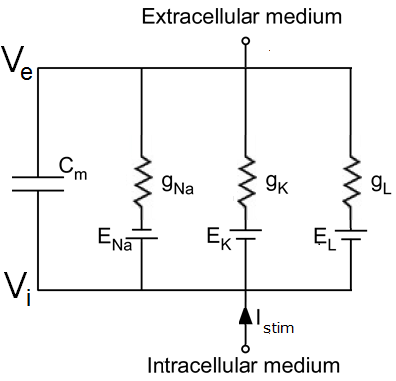Bioelectricity: Electric model of the cell membrane
 Membrane potential when three or more types of ion channels are involved
Membrane potential when three or more types of ion channels are involved
The model for two ion channels can be extended to three or more ion channels. For convenience, we summarize below the other ion channels by a single so-called "leakage channel" having conductivity \(g_\mathrm{L}\). Then we have an analogue of an electrical circuit that looks as follows:

In this figure, we have also drawn an imposed current, \(I_\mathrm{stim}\). The membrane potentental is defined as \(V_m=V_i-V_e\)
From Kirchhoff's junction rule it follows that the imposed current \(I_\mathrm{stim}\) is equal to the sum of the currents of the ion channels and the capacitor; along with Ohm's law this leads to: \[\begin{aligned}I_\mathrm{stim}&=I_{\mathrm{C_m}} + I_\mathrm{K}+I_\mathrm{Na}+I_\mathrm{L} \\ &= C_m\frac{dV_m}{dt} + g_\mathrm{\small K} (V_m-E_\mathrm{K})+ g_\mathrm{\small Na} (V_m-E_\mathrm{Na})+ g_\mathrm{\small L} (V_m-E_\mathrm{L})\end{aligned}\] If we define the resting membrane potential \(V_r\) define as \[V_\mathrm{r} = \frac{g_\mathrm{\small K} E_\mathrm{K}+ g_\mathrm{\small Na}E_\mathrm{Na}+ g_\mathrm{\small L}E_\mathrm{L}}{g_\mathrm{\small K} + g_\mathrm{\small Na}+ g_\mathrm{\small L}}\] and define \[V=V_m-V_r\], when we consider the potential difference with the resting membrane potential, then we get the following differential equation (check!) \[I_\mathrm{stim}=C_m\frac{dV}{dt} + (g_\mathrm{\small K} + g_\mathrm{\small Na}+ g_\mathrm{\small L}) V\] If the stimulus is equal to zero, then the differential equation is the same as that of a discharging capacitor. In a cell that is not at rest, but has, for example, a bonzero starting value of the voltage \(V\) at time \(t=0\), the voltage will approach the original potential via an exponential decay process, according to the formula \[V(t)=V(0)\cdot e^{-\frac{g_m}{C_m}t}\] where \(g_m\) is equal to the sum of the conductitivities of the ion channels.
\(\phantom{x}\)
In reality, the situation is even more complicated. For the channel conductivity \(g_{\mathrm{ion}}\) one often takes the product of a maximum channel conductivity \(G_{\mathrm{ion}}\) and the chance \(p\) that the ion channels are open and ion transport possible; this probability depends in many models on the potential and time. We will see this when we discuss the Hodgkin-Huxley model for action potentials in nerve cells.


